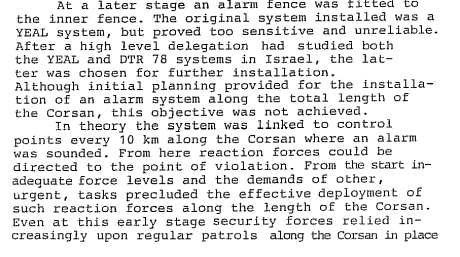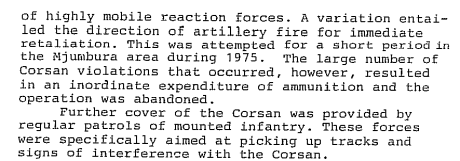Basil Preston continues with his brilliant recollections…….a fantastic addition to a blog that is slowly becoming a definitive part of the Rhodesian Corps of Engineers history.
Rhodesian Navy: Boats on Kariba Binga stint (Oct 1973)
Intake 132 did their boat-training at Binga. We made camp at the back harbour. Corporal Hydes was our instructor at the time. We trained in the 1945 Hercules and a South African Sail Fish boat. See pics below: 



 Kariba stint (Oct 1973-Feb 1974)
Kariba stint (Oct 1973-Feb 1974)
Doug ******* and I were attached to the Selous Scouts based at Kariba Heights. Sergeant Ant White was in charge of us. I was a banker by profession and Doug was; I don’t really know, as he was a jack of all trades, but master of none, except womanizing. He was engaged to two women at the same time, one was a Wankie mine disaster widow and the other was a sweet young lady he met in Salisbury. At Kariba, he picked up another potential fiancé, I suppose this was his strategy of getting laid… Our first job was to retrieve our Hercules boat from below the Kariba Dam wall, where it was used by the previous operators, don’t know who they were. Apparently, at full throttle, both Johnsons kept the boat at a standstill. And this was against the water current from the dam turbines’ out-let only. Also, apparently, when the Sappers who operated this boat originally, went down to the boat, the Zambians would come down and try to intimidate them, by pointing their weapons at them and shouting abuse. The Sappers responded by giving them a full bare-butt salute. See pics below: 


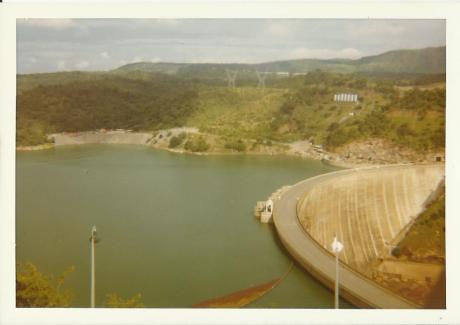


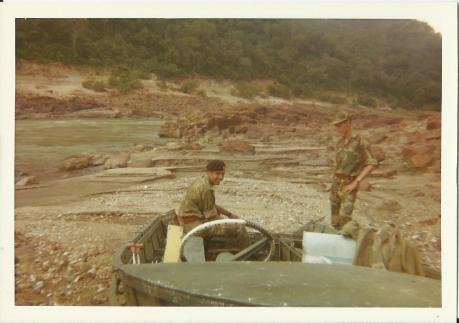 Our second job on the boat was basically to service our 2 x 40hp Johnsons, which Doug did exceptionally well. During our training, no one told us that whilst in a harbour, we were not allowed to do speed-tests, which was just messing around really. But when we were called in front of Col Ron Reid-Daly, we realized that we had caused major upsets with the other civilian boat people, as their tools etc could have been donated to Andora harbour’s murky waters. We both were made to feel like “you know what” and we both were taught a valuable life-lesson that day.
Our second job on the boat was basically to service our 2 x 40hp Johnsons, which Doug did exceptionally well. During our training, no one told us that whilst in a harbour, we were not allowed to do speed-tests, which was just messing around really. But when we were called in front of Col Ron Reid-Daly, we realized that we had caused major upsets with the other civilian boat people, as their tools etc could have been donated to Andora harbour’s murky waters. We both were made to feel like “you know what” and we both were taught a valuable life-lesson that day.
Early January 1974, during our service with Ant White, we (Ant, myself and Doug) were choppered out to a land-mine blast at “D” Camp, at Chirundu. These camps were hunting lodges alongside the Zambezi. A South African Police team were returning to their base camp when they bummed a lift from the National Parks guys; they were using two Rhino vehicles and both were over flowing with SAP and National Parks rangers, Kevin Woods, who was with the National Parks and travelling in the second vehicle, was sitting over the step-up of the Rhino vehicle. As they were leaving “D” camp, the second Rhino hit a land-mine. Kevin’s feet were badly injured, he lost one foot. And the SAP in the vehicle were all injured, one having a broken back. As our chopper dropped us, so it took the first bunch of casualties to Wankie hospital and had to return for more. We started our mine clearance immediately and the three of us were off. I noticed elephant footprints and they were fresh, so I prodded them too, and was rewarded with my first land-mine discovery. The terrs had laid one and disguised it in a footprint. Shit, I started to shake and then we realised that the laying had been done very recently, as when the Rhino vehicles had gone into “D” camp, they would have popped one as the vehicle tracks went right over the mine. So the terrs were close by. We disarmed the mine and then were told that we had to sleep over as the chopper could not return to collect us as it was too dark. I don’t think the three of us got any sleep that night. As when we were choppered in, we just had our webbing and prodders with us, no food etc. Again I had visions of the Kariba spider doing its worst to me. Another lesson was learnt here; be prepared for the unknown, as your lift back may be delayed.
On another mission we attempted to take one stick of (1 x 4) Selous Scouts to Fothergill Island in our Hercules boat, but right from the start into the trip we started to take on water as the waves got progressively bigger as the day grew older, and we set off late in the morning; rushed idea by someone at the top. Luckily we were assisted by the “Janet” launch, (sister ship to the Armenal; Janet, was Ian Smith’s wife’s name, and the Armanel was President Du Pont’s wife’s name, the wives were sisters too if I recall correctly). We were thankful for this as we were following instruction only and still had a lot to learn about actual mission work. For example the thumb tip of an open hand to the tip of the “bird” finger equaled 2 x full tanks of juice. And our boats could only take 4 x passengers and two Sappers only, and 2 x fuel tanks only, so our mission was aborted. We could have been the first boat crew to go down (not only been sunk) in history but with the Selous Scouts not being too happy either.
Ops from here on were better planned and were not so ambitious. Another op was very secretive, in that no one, not even Doug was allowed to know of. I had to take two Selous Scouts to a destination beyond Chirara, and help set up a terr base camp. This included everything one would expect to find in a base camp, even dirty woman’s clothing, cooking pots, food, fire places, uniforms etc. We even had to build make-shift lean-to’s. Plus dig shell-scrapes and some trenches. This was for training purposes. Ant White’s trainees were to find this base and then, who knows what? Interesting out-door work to say the least.
At about the same time, Ant was training up the first Territorial tracker unit, which also had to undergo a form of Selous Scout training. One such op related to survival training. After an intensive 6 weeks of training, these chaps were then told that they are off to go see the snake park, and they were to come as they were dressed; PT shorts, camo shirt and takkies only. They were taken to the harbour, and before boarding “The Janet”, they were searched. The search was to find anything that these guys could use to help survive. As they had to survive by using what skills they had been taught during their training. Sometime during their training, someone lets a few tricks of the trade out of the bag, and these trainees were told to expect the unknown and to hide things like match-heads, short pieces of wire, in the seam of the shirt-pockets and PT shorts. But Ant White was wise to this. Each guy was thoroughly searched and I doubt anything got passed him. We dropped a group off on each Island. One island was called “189”, it’s the biggest island you can see from Kariba Heights, and then there are two smaller islands to its right. (The very small island on the extreme right, I was told, is where Andre Rabe, the first Selous Scout killed is buried.) See pics of the two teams, one guy is holding the shell of a tortoise he found and ate: 

 Our function as the boat crew was to be on stand-by during the week these trainee trackers spent on the islands. We speared fished daily and generally had a good time. We smoked the fish over a fire etc. The only problem we had was with mother-natures hippo, as we set up our camp right on a hippo path, because it was clear of vegetation and the dreaded Kariba Spider, these spiders caught birds in their webs etc, and innocent Sappers too. However we made sure our fire was kept burning, especially at night. Not my idea of an ideal camp site…..see pics:
Our function as the boat crew was to be on stand-by during the week these trainee trackers spent on the islands. We speared fished daily and generally had a good time. We smoked the fish over a fire etc. The only problem we had was with mother-natures hippo, as we set up our camp right on a hippo path, because it was clear of vegetation and the dreaded Kariba Spider, these spiders caught birds in their webs etc, and innocent Sappers too. However we made sure our fire was kept burning, especially at night. Not my idea of an ideal camp site…..see pics: 


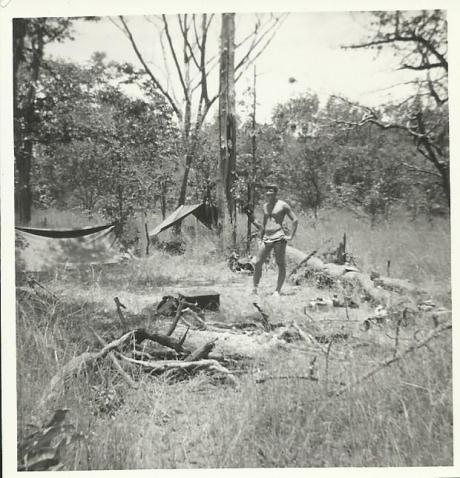 If anything was wrong with the trainees, they were to build a fire and we would come boating. Yes, we had a couple of night fires that we had to attend to. One was a snake bite, and another was a scorpion bite. Also one guy’s venereal disease played a role of him being boated off the island and off the course. Good thing that the trainees knew how to make fire. Our biggest problem on Kariba, especially at night is navigating the boat through the dead forest of Mopani trees. We destroyed a few share-pins, and changing these at night was a nightmare (also see https://fatfox9.wordpress.com/2015/04/02/on-the-boatsup-the-creek-with-the-sas-part-5-also-known-as-eight-men-in-a-leaky-boat/). When it was my turn to change one, I could always see a dam crock in my mind, so I did this job very quickly while Doug watched with his FN at the ready. Perhaps if a crock did show, would Doug know what to do? I am still here, so no crock fancied me. I also had the pleasure of spear-fishing with Sergeant Stretch Franklin, of the Pioneer experimental pseudo group. We and some others took the boat out for a fun day, i.e. spear-fishing.
If anything was wrong with the trainees, they were to build a fire and we would come boating. Yes, we had a couple of night fires that we had to attend to. One was a snake bite, and another was a scorpion bite. Also one guy’s venereal disease played a role of him being boated off the island and off the course. Good thing that the trainees knew how to make fire. Our biggest problem on Kariba, especially at night is navigating the boat through the dead forest of Mopani trees. We destroyed a few share-pins, and changing these at night was a nightmare (also see https://fatfox9.wordpress.com/2015/04/02/on-the-boatsup-the-creek-with-the-sas-part-5-also-known-as-eight-men-in-a-leaky-boat/). When it was my turn to change one, I could always see a dam crock in my mind, so I did this job very quickly while Doug watched with his FN at the ready. Perhaps if a crock did show, would Doug know what to do? I am still here, so no crock fancied me. I also had the pleasure of spear-fishing with Sergeant Stretch Franklin, of the Pioneer experimental pseudo group. We and some others took the boat out for a fun day, i.e. spear-fishing.
2nd Binga stint (1975)
(The Binga stint was during the period we were building Causeways through out the roads off the main Binga road, towards the dam area between Mlibizi and Binga. Keith Bing was with us and what a character he was; he was the grader operator. It was our luck that the RAR needed boat operators, and they were camped at Binga), Dave Stewart, he was from Fort Victoria, was my partner on the boat when we were attached to Major Drake of 1RAR at Binga. We also undertook combat engineer duties too. We operated from the front harbour of Binga, left to Mlibizi, and right to Sinamawenda, (sp) the research station past Chete gorge and all the little islands between these two points. RAR soldiers on a boat is a nightmare, as they have a fear of the water. By this time, we had learnt that being on the lake, ones mission had to start at 04h00, this was when the lake was at its calmest. Kariba’s progressive waves can get as big as 3 metres or more, this is the radius height, so in actual fact, the progressive wave’s diametre is 3 metres in size. I.e. imagine an “S”, from the top of the S to its middle, is what is above the water, this will be 1.5 metres and the bottom is under the water, another 1.5 metres, and is moving in whichever direction the wind was blowing. And popping these waves head-on, sends shudders through the whole body. It was a wonder that our little boat survived the thrashing. The RAR guys turn white/grey and just hang onto their dog chains and pray to their ancestors, all their weapons and kit is also secured to the chain. We also had a Machine gun mounted on the front deck, which also took a beating. We were a Mercedes crew travelling in a Mini. I have often had a stand-up shouting match with Sergeant Majors who want to move around on the boat. As before we start our mission, we balance out the weight, and any movement upsets the plane etc. We explain all this shit to them, but having a fear of water is very strong. Major Drake would tell these guys that we are in charge, no matter what, but we still had plenty of verbal punch-ups. We took sticks of RAR soldiers to the islands, dropped them off on one side, and then tiger-fished all the way round to the meet-up point. Great fun, but nothing went to waste. The RAR cooks got most of the tiger we caught. And we also threw some tigers to the beloved fish-eagle, the one with the white head and brown body. A true african beauty, especially its cry. I have a 5kg Tiger from my RAR stint on my wall to-day (1975). Plus one from Mtetsi Mouth caught whilst doing the Deka mine-field in 1978.
Dave and I had to go to Sinamawenda (sp) Research station as the terrs had crossed over and took some of the staff hostage. This trip with a stick of RAR soldiers was worth a medal in itself as it was a fairly far trip with non swimmers. The terrs also ransacked the place. However, months later it came out that a certain RR company were there and had also ransacked the place as well as Sijarera Fishing camp (sp), which is on the same route. This came about when an Engineer Lieutenant ******* acquired a pistol and tried to license it. During the license process it was discovered that this weapon was reported stolen from Sinamawenda (sp) Research station. This discovery was bad news for Senior Military personnel as a few officers were “cashiered” from the army. A sad day indeed.
Van der Riet’s hunting camp 1975
During Dave’s and my camp with the RAR, the District Commissioner of Kariba was flying to Wankie, and was overhead Van der Riet’s hunting camp when he spotted a Land Cruiser which had detonated a land-mine. A chopper was dispatched to collect the injured, and Dave and I spent nearly 12 hours in a 4.5 getting there to look for more mines. Peter Parnell had started the up-grade of this escarpment road, but was ambushed a couple of months earlier and killed at Crocroft Bridge (sp). We arrived late at night and started to clear the area. But being so dark etc we were not doing justice. So we slept a crap night and resumed our search in the morning. The road had a “Y” intersection, and the mine was placed on the hunting camps road. We did a 2 kilometre length search on the other section of the “Y” to no avail. It was the norm for the terrs to lay 2 mines in tandem, so after doing 2 kilometres we decided that it was clear and also no antii-personal mines were planted on the verges. We were thorough Combat Engineers back then. We then were treated to a breakfast at the hunting lodge, where a group of Americans were visiting. They wanted to take pictures of all of us. But Dave and I refused. We had one RAR machine gunner with us, and when the yanks wanted to take pictures, the other RAR guys nearly killed themselves, all diving for the machine-gun. This is a prestigious weapon to be photographed with. Dave and I lost respect with the Yanks, they showed us their bragging photo albums. There were pictures of taxidermied squirrels holding ashtrays, etc , and when David saw the Yanks posing with a Sable bull which they had shot, he lost it. He was very vociferous about this. Van der Riet took us aside and tried to calm us down. He said that Rhodesia needed the foreign currency etc, and each guy was paying $1,000.00 USA a day, (1975) plus each animal shot had its own price tag above the daily rate, and they had already over-stayed by a week and were threatening to leave soon if they had not got their quota elephant. Van der Riet went on to explain, that his trackers would strategically place elephant dung in the opposite direction of where the elephant was, just to get more days out of the yanks. But at the end of it, the elephant had to be sacrificed for the good of the Rhodesian economy. The people injured by the mine blast had shit for luck. As on their way to Wankie, their chopper developed mechanical problems, and Kariba having the forest of dead Mopani trees and Kariba weed etc the pilot wanted to crash-land his chopper without damaging the rotors, as we were told that SA was selling them to us at a hugely inflated price. Being dusk, he took the Kariba weed as being solid ground and seemed to be clear of dead wood, he was able to put his chopper down, but it sank, and the rotors were also damaged. So, instead of us heading back to Binga from the hunting camp, we were directed to go and assist with the recovery of the sunken chopper, just short of Mlibizi Also, on a follow-up call-up to Binga, Peter Parnell’s team were still busy with the road to the hunting camp, when his grader operator unearthed the tandem mine. This time we were choppered there, and were thankful that the mine was not found in the section of road we had cleared, we were about 500 metres short of finding it the first time. So we learnt that a tandem mine has no set distance.
What a camp?
Basil Preston.
Please also have a look at my website dedicated to Rhodesian and South African Military Engineers. Please join us on the forums by using the following link:
http://www.sasappers.net/forum/index.php
Copyright
© Mark Richard Craig and Fatfox9’s Blog, 2009-2015. Unauthorised use and/or duplication of this material without express and written permission from this blog’s author and/or owner is strictly prohibited.











